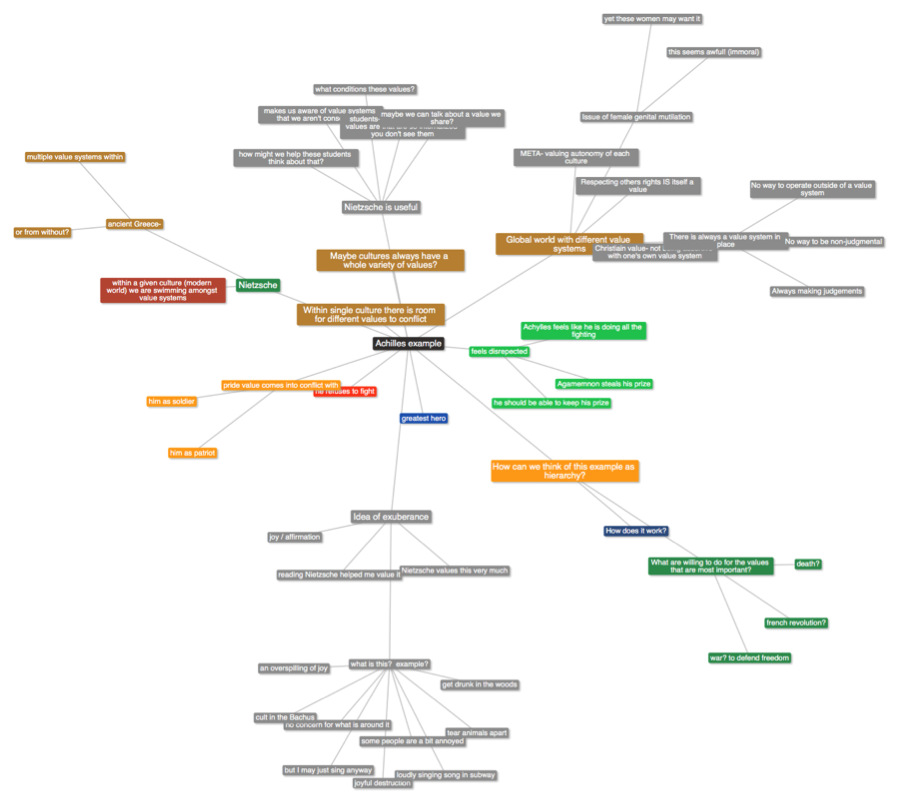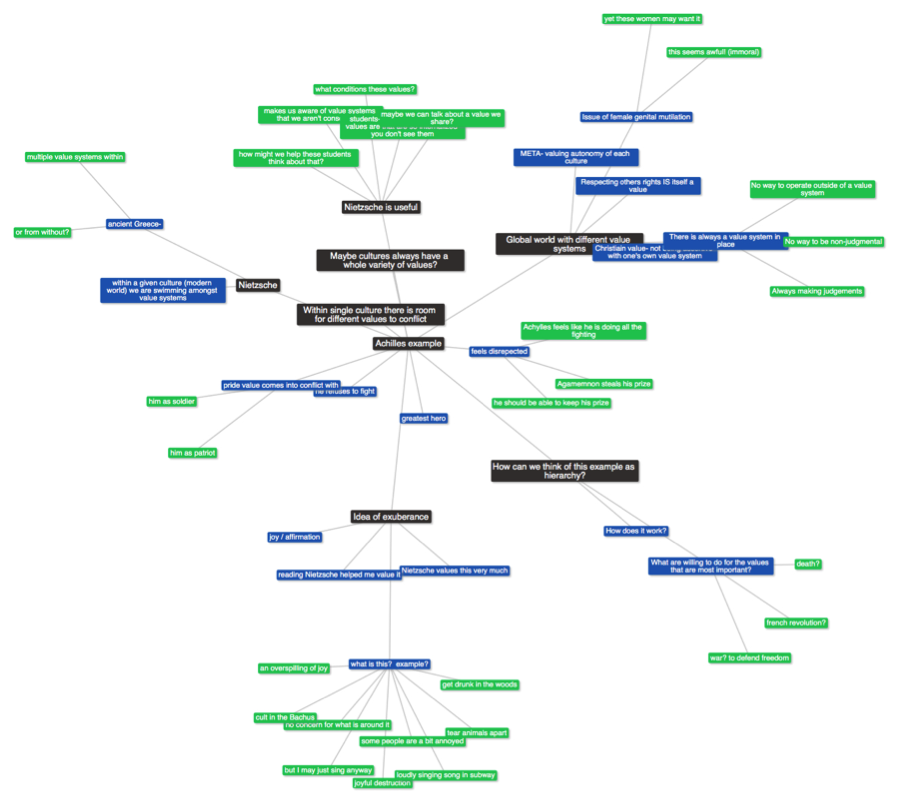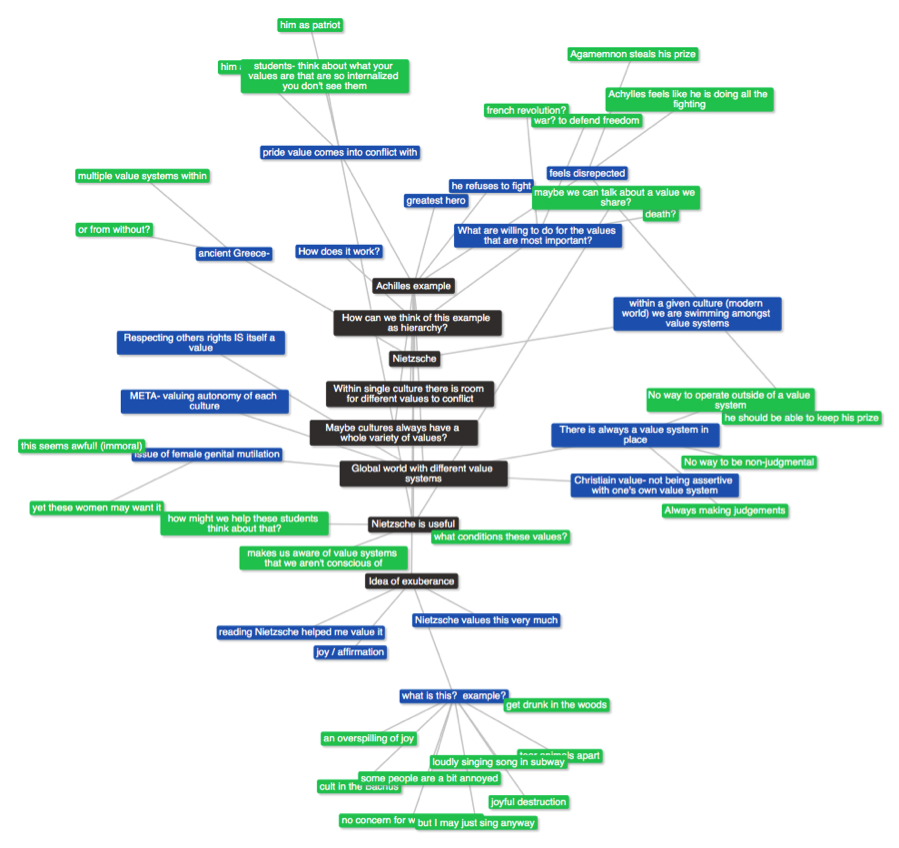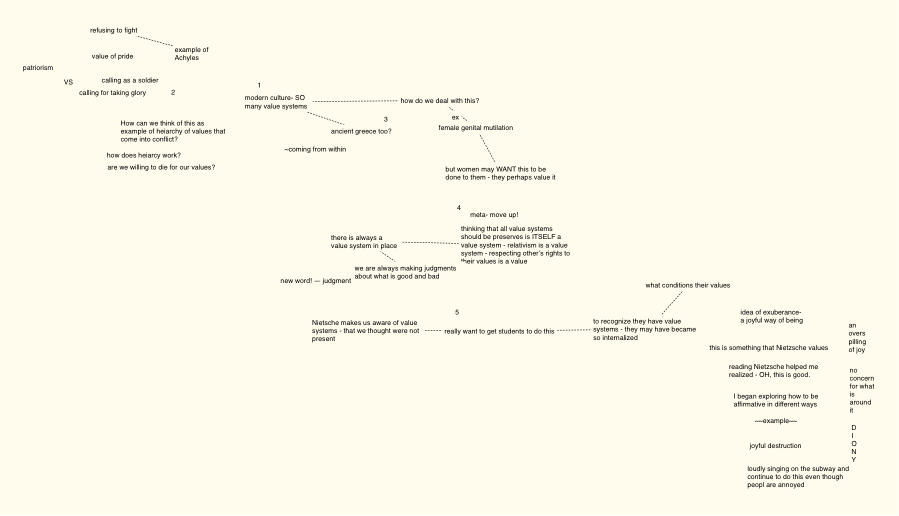BOOTCAMP- revisiting and radicalizing the mind map
For my 2nd probe I conducted an experiment with a common mind mapping software program called MindNode Pro. The main thrust of the probe was to show how this mind mapping software re-inscribed linearity into a practice (mind mapping) that has the potential to be radically non-linear. The argument was conducting by trying to mind map a pre-recorded conversation, which helped to point out key problems with the program. Conversations, much like mindmaping are also radically non-linear. But in what different ways is this non-linearity inscribed? From original conversation, to audio recording, to mindmapping software that maps the audio conversation, there are a number of changes that are undergone. How does each new medium or tool that we introduce re-create elements of the original conversation? How does it depart from these?
For this BOOTCAMP I took a conversation that I had with a friend while walking. The conversation was about values. We took an audio recording of this conversation while it was occurring.. For this BOOTCAMP I listening to this audio recording three times and each time I listening I created three “translations” of this audio copy: 1) a written script 2) Text2MindMap mindmap 3) Scapple mindmap.
After creating these translations I was left feeling the need to go back and re-think what exactly is happening in conversation that I am trying to “emulate” or “reproduce.” So with that in mind, I will begin this written component of the BOOTCAMP by explaining these core elements of verbal conversation.
There are a few aspects of the original conversation that I would like to point out that I will continue to return to throughout: liveness, presence, indeterminacy, non-linearity, participation. Liveness is the fact that the conversation is occurring in real-time; it is happening in its initial iteration. Presence relates to the temporality of this live conversation – it exists in the present and most importantly leaves no sensual trace. Participation is our ability to produce signifiers that determine the movement of the conversation as it moves within this present field. Indeterminacy is the quality that we have no idea where the conversation is going to go as it is unfolding. Non-linearity seems to come out of this indeterminacy. Because we don’t know where we are going we are unable to move in a straight line.
My project is concerned with the notion of translation, transcription and representation. What happens to the copy of the conversation once it already exists. What happens when we re-inscribe the initial conversation into different mediums? Why even try to create copies of conversation? Well, one of perhaps the most unfortunate qualities of conversation is that it disappears as soon as it appears. Outside of the technology of writing or recording most cultures have solved this issue through oral repetition. This process raises a whole series of interesting questions which cannot be explored here. But it should be noted that this process of oral re-counting and repeating, and perhaps only this process, retains the live-ness and presence of a conversation as its medium of translation is almost exactly the same as the medium which produced the initial conversation.
The initial translation that I performed was that of an audio recording. In the audio recording the quality of liveness is gone and also the quality of participation- we are not there to participate. However, the quality of presence is retained. For despite the fact that traces are left (i.e. the audio recording) we are unable to stay with any trace- it disappears before us as soon as it appears. This quality of the audio recording is perhaps the most important and relates exactly to the difference between a verbal utterance and a written utterance. The written utterance continues to stand there after and while it speaks. The questions before us all relate to this standing. How does the written word “just stand there”? How does it standing relate to the other factors of conversation?
The next translation I performed was to write out the text as a common script:
N: The story begins with Achilles, the greatest hero among the Greeks feeling as though he has been disrespected. The reason for this is because Agamemnon has stole his prize- a slave girl. Achilles feels like he has been doing all the fighting. He should be able to keep his prize. He refuses to fight. For the entirety of the poem he is not fighting. He values pride. Yet this value of pride comes into conflict with his calling as a soldier, his calling for taking glory and his patriotism. Him not fighting is causing all these people to die. This is a conflict of values. I wonder, how can we think about that as a hierarchy of values that comes into conflict in order to think – how does this hierarchy work? What are we willing to do for the values that are most important? Are we willing to die for them?
F: One place that I am interested in moving the conversation. One thing that I want to mention (and this brings us to the Nietzsche) is this idea that we, within a given culture, especially in the modern world now, are swimming amongst value systems. I don’t know what the story is in Ancient Greece (whether there are multiple value systems, I’m not sure)… if the conflict of values is coming within Greek culture or other cultures? That is interesting. That within a single culture there is room for different values to conflict. This goes against what some of our thoughts are against how a culture has a clear value. Maybe cultures always have a whole variety of values that you encounter.
N: I don’t know if it goes against that. I think you can have a system of values and you can create situations in which those values come into conflict even when they are coming from the same source. But, turning back to this idea of different…we live in a global world where we encounter different value systems and how do we deal with those. Something that comes to mind for me is female genital mutilation in certain cultures that to us seems very awful, very immoral. We live in a culture that at least says that it values the equality of women and men. And yet different cultures are organized different. Those victims may in some cases may want those things to happen to them to continue their traditions
F: It is interesting because what you were just saying – genital mutilation is one culture and our culture is another culture- that itself, what you were just saying, is a value system- you are valuing the autonomy of each culture. You can’t escape value systems. Even if you are valuing the values of each culture you have a peaceful mentality. Perhaps even a Christian value of not being assertive.
N: Respecting other people’s rights is itself a value- multiculturalism. So you are saying that no matter what, where we are comfortable with it or not there is always a value or not and so we are always making judgment about what is good or bad.
F: I mean, that is bringing in a new word- that is judgment. But I would say that there is no way to operate outside of a value system.
N: So, lets turn back to this idea that I really want to explore this semester which is…I think that Nietzsche is really useful because he makes us aware about value systems that we have that we might not have been conscious of before. He makes us question those. That’s something that I really want to do with my students this semester- think about what those values are that may be so internalized that they haven’t realized that they are choosing one thing and not another. But also thinking about what conditions them. And one of the first writing assignments I will have my students do is write a short essay about trying to get to their values…trying to investigate what their values are and how might we help them, how might we help them think about that? Maybe we can talk about a value we share… talk through how we may not have seen that until a certain moment.
F: Ya, that is interesting, I guess…the first that came to my mind is the idea of exuberance and a way of being that is joyful and affirmative and I mention that…that is something that Nietzsche values very much and I think reading Nietzsche helped me realize- oh this is very good- I like this a lot. I started exploring how to be affirmative in different ways, which has different manifestations.
N: Can you talk a little about what exuberance is? And maybe an example?
F: So I see exuberance as…an over spilling of joy…a joy that has no concern for what is around it.
N: Very Nietzschean indeed.
F: And the example that Nietzsche uses is the term Dionysian. It goes back to Greek culture. There was a cult of Dionysus and in Euripides play, the Bacchus, what happens is this cult, they get drunk in the woods and they have these ecstatic and joyful festivals and part of what they do is massacre and tear apart animals in this drunk frenzy. It is a joyful destruction. I don’t advocate that. But I do think that there are certain ways of being that have this certain kind of joy. For example being on the subway and being around people who are upset with a low cast gaze and I may start loudly singing a song, and some people may be annoyed with that, but I may continue doing anyway.
A striking aspect of this written transcription is its linear flow. It flows in a particular direction- left to right, top to bottom. Another clear quality that has been represented is who is speaking and what is said. This written account seems so precise, but in its precision it excises key conversation qualities. Clearly, it produces a linearity in the way it is meant to be read. There is one start; there is one finish; there is one potential path to engage in this transcript. Participation gains a new meaning now. Clearly we cannot participate in the initial conversation itself. However, each “translation” or mode of transcription offers the opportunity for participation. The linearity of script above, allows participation, but offers only one path for participation- that of starting at the beginning and moving to the ending. Indeterminacy also gains a new meaning here. When we face any written transcript there is always something determinate- the text itself, because now the words continue to stand there. Indeterminacy is now measured in how many ways one can move across a text. Linearity removes indeterminacy.
This is why mindmapping programs are so effective. In mind mapping we can begin to bring back the qualities of indeterminacy, non-linearity and participation that the initial verbal conversation contained. We being to translate conversations not based on their content but on their form.
For this project I used two radically different mind mapping software programs. One- Text2MindMap” functions more textually. The other- Scapple- functions more visually.
The first program is called “Text2MindMap” (www.text2mindmap.com). This program gives you the opportunity to enter in text and then once entered you can convert this text to a mind map. This program makes visible what many other mind mapping programs make invisible. In other words, most mind mapping programs (including MindNode of my prior analysis) construct their mind map using a hidden textual interface which ranks textual values and thereby constructs a hierarchical mapping. Text2MindMap makes this explicit- it doesn’t pretend to be something that it is not. Textual values are ranked by being primary or secondary by pressing “tab” to go down the hierarchy or “shift tab” to go up the hierarchy.
This program has a very particular positive advantage to my conversation translation- it allows great speed. The interface is extremely user-friendly. I was able to very quickly enter in text and not have to worry at all about where I placing the text. In this mind mapping program the user does not do anything with the visual realm while typing. The only consideration to make while I was typing was whether or not a particular claim goes with the one prior. Is this new element in the conversation something radically different, or does it relate to what was said before? If it is radically different I merely press “shift tab” and assign it an entirely new value. If it is dependent on what is prior I merely press “tab” and place it under the prior claim. The speed at which I was able to conduct this task made me able to capture the majority of the conversational content.
When I “converted” the textual Mind Map to a visual Mind Map I was immediately struck by something strange- my first claim I transcribed was in the center of the Mind Map. Additionally strange was that this claim was then connected to all the other claims which should be at the same hierarchical “parent” level as this claim. Why? I was immediately upset, because this is another hidden coding that is moving against my intentions. The “Achilles example,” the “idea of exuberance,” the “Global world with different value systems” all do not connect to each other, and the indentation I provided in the textual field does not indicate that they do connect. I found that I was able to go into the options field and change how the coloration works such that all the “parent” claims were the same color. This color (black) would then indicate the top hierarchical level:
Then I realized that I could easily alter the map itself to make this more visible. I changed the placement of the central black terms so that they were arranged going downwards to indicate the movement of the conversation itself.
This map can now be read like a text. It could be followed going downwards as one’s eye goes down a page. But do conversations move downwards? Does the downwards movement of a page mean the movement of time in a conversation? Have a re-inscribed the linearity in the page once again?
Figure 1, because of its overuse of color, is not able to use color to inscribe hierarchy. Rather it makes a statement of immediacy. The claim in the center captures our eye immediately. It is at this point we start- the initial point of the conversation. And further moments of time are seen as branches out of this initial moment. Figure 1 is more chaotic. We don’t know where to go. We don’t know how to proceed. So we are forced to re-map, we are forced to find our own movement of the text. In that sense we are forced to form our own conversation and make a-new the conversation within the map. Figure 1 enables a more radical type of indeterminacy, non-linearity and participation because it runs against the grain of representation. And this movement against the grain was afforded by a giving up of control that existed within the conversion of the textual mind map to the visual one and the somewhat “random” connections that were inscribed in the conversion.
The movements from Figures 1 to Figure 2 and from Figure 2 to Figure 3 were all based on the desire for more “factual” representation of information. Both are motivated by the memory of the conversation itself. After a conversation occurs, our memory of it, and of its components, inscribes a certain kind of linearity- one that says the conversation started with A, then it moved to claims B and then it moved to claims C and then D. We see this even with the audio recording, but less clearly perhaps. However, it is very important to note that this movement was not present within the initial conversation. These flow from moment A, to B to C to D do hold a key advantage when represented in transcription: they allow us to commemorate the conversation by re-tracing the path that the conversation lived. They allow us to re-live the conversation itself by existing within each worded component that occurred while it was occurring. This is also the advantage of the linear written transcript.
It should be noted that all the Mind Maps from Text2MindMap (Figures 1, 2, 3) have another important quality that is not present in the linear transcript: they visually represent the movement from one idea to the next. They do this mainly through the line that occurs between one idea and the next. What does this line do? What does it allow? I believe it allows us to map conversation time more effectively. Conversations have lags, pauses, swells. Pure symbolic worded representation does not allow for these to be translated. The lines between ideas on a mindmap are new symbolic forms we can use to begin to represent the way in which ideas come about. Lines may not only be pauses or gaps between ideas; we can extend the lines to make longer the movement between ideas. We can make double lines or triple lines to show the connection was a vital connection. We can use pictures to map qualities in the conversation that were lost when they entered their audio transcript and then their written transcript. We will see this visual element even more pronounced in the next Mind Mapping software I explored.
The second program I tried was called Scapple. Scapple seemed too good to be true. It was as if they had anticipated my initial critiques with Mind Mapping software and made something specific to me. Their website describes Scapple as the following:
Scapple doesn’t force you to make connections, and it doesn’t expect you to start out with one central idea off of which everything else is branched. There’s no built-in hierarchy at all, in fact—in Scapple, every note is equal, so you can connect them however you like. The idea behind Scapple is simple: when you are roughing out ideas, you need complete freedom to experiment with how those ideas best fit together.
The following is my transcription of the conversation using Scapple:
I found the process of transcribing in Scapple to be extremely invigorating. Scapple truly is a visual program that doesn’t inscribe the hierarchy of traditional mind mapping software. One can create new nodes anywhere. Every node is equal to another node. One creates a node quickly by double clicking anywhere. One then can easily establishes connections between nodes by dragging them into another and then a line is displayed between them. I found that I could create connections in ways I was unable to before- by arranging the text itself around the prior text to create visual connections.
Because of the visual layout, I was able to play with visuality, spacing and diagraming as means of delivering meaning in the verbal conversation that would perhaps otherwise be lost. In the Achilles example there is the idea of different values that were in conflict within Achilles. These values were able to be represented alongside one-another and I could depict their conflict by writing a VS in-between the values. Another example is in the segment of conversation where I mentioned that my interlocutor was introducing a new word- that of judgment. While creating the transcript I deemed this to be a slightly irrelevant claim to the overall trajectory of the argument. So I placed this claim off to the side. I used the visual spacing to indicate distance from the main trajectory. Another example is when I wrote out the word “DIONYSUS” downward and alongside the words that explicated this example. DIONYSUS was the name of the example. One could read the specific claims that explicated this example while one’s eyes peripherally saw the word DIONYSUS running beside them, thereby keeping clear about what the example itself was about.
In my initial re-reading of my Mind Map I found myself frustrated by the quality mentioned above- that the Mind Map did not commemorate the trajectory of the conversation itself. So, I decided to insert numbers that could guide a reader though the conversation should they choose to use them. These numbers could exist on the side of mind maps (not connected to any node). Moreover I could make them small and not imposing so that a reader wouldn’t feel locked into the linearity they may prescribe.
What bearing does this visual form of writing have upon the transcript of the conversation? Does it enable certain key components of the initial live conversation? I would argue that the strongest element that Scapple adds is that of participation. As the user who created this document, I am constantly invited to re-map the conversation. The endless and multiple ways in which I can move and shape the text and extra-textual visual devices exaggerates my role as a participant. Interestingly, it is this quality that affects both the non-linearity and indeterminacy. We aren’t clear how to read the text. Take the example of DIONYSUS. Should I read the DIONYSUS first or the examples around it? Actually we are meant to read both simultaneously. DIONYSUS is meant to be in our periphery as we engage in the explication. Simultaneity imposes linearity. The call to constantly revise, as a user, is a call for indeterminacy, for the text to never remain constant or stable. As a reader, the indeterminacy is created in the multiple pathways we can engage with text: different starting points, different ending points, different middle grounds. Each time we engage the text we can have a different experience. The visual elements are what allows for this.
Andrew Piper in his article “Reading’s Refrain: From Bibliography to Topology,” has much to say about texts that exist more visually than textually. While the article focuses on topology, I think many of his claims work equally well regarding mind mapping- especially on the level of the program Scapple that I was using. In re-reading the mindmap of Scapple (and in creating and re-creating mind maps with Scapple) we aren’t asked about what a particular idea fundamentally is; rather the programs creates, “the conditions of putting words into an endless set of relations.” (380) The idea of DIONYSUS can come at the beginning or in the middle or in the end, and we can place it closer or further away from the whole set of ideas that are around it. For Piper, “topology argues that ideas are constituted by contingent sets of words, sets which mutate over time and space and which are by no means dependent on a single, controlling term.” (383) It is remarkable to me how much this quote echoes the qualities of a conversation- especially in regards to the mutations of meanings. I think with a program like Scapple this mutation of meaning is certainly present as the program encourages constant re-mapping and re-formattings of text. There is no possible single controlling term, as there is no single possible way to format the text. The program invites us to keep experimenting, to keep re-positing and re-framing. This type of radical mind-mapping technique moves us away from enlightenment standards of meaning which involve dispelling of doubt and increases of clarity and actually create greater and greater entanglement (384) The word is no longer merely seen as a sign but also as an “action waiting to happen.” (385)
Works Cited
Piper, Andrew. “Reading’s Refrain: From Bibliography to Topology.” English Literary History 80 (2013): 373-399




